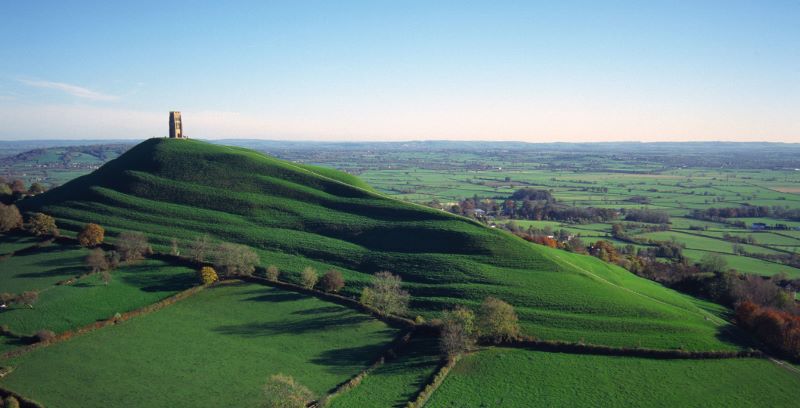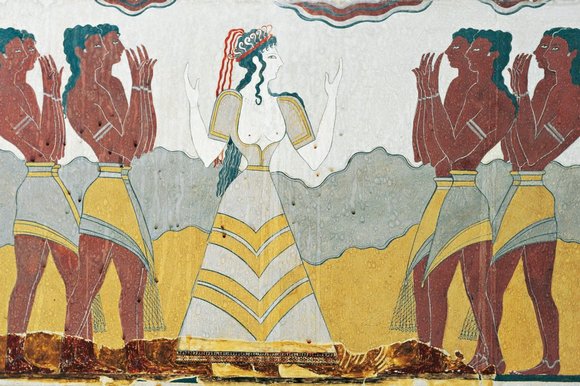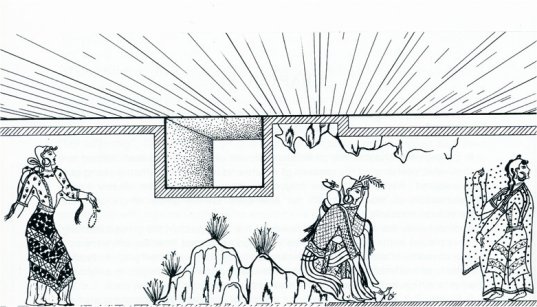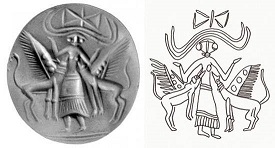
In this Goddess conscious world of the Idaeans, shrines were built to the Goddess on mountains tops, and they built their spiral on the Tor because it was the ideal shape to represent the Goddess.
A Breast shaped hill. The broad Breasts of Gaia, Mother Earth supports all mountains.

When men love a woman as goddess, then love becomes worship.
In Minoan Spirituality, a priestess would wear a long dress with an open top, baring her breasts. The open top baring her Breasts is also at the same time the focus of her religious beliefs, as a 'breast centred Goddess consciousness' the Sacred Breast, for her to commune with and pray to the Goddess, and also as a channel to the Goddess allowing men to respect and pray to the Goddess in ritual, as well as forming a deep sensual connection with their partners. As daughters of the goddess in Minoan worship a priestess would commune with the goddess by inviting her love into her heart and in meditation/prayer, she would then focus on this area which is prominently surrounded by her breasts. When a woman focuses on her breasts with reverence, the feminine heart is honoured and responds by naturally overflowing with love from the goddess.
Feel the love of the goddess flowing through you, as you are a divine channel to the goddess. What is she saying to you about you, and your relationships, your emotions and your innate confidence? Brings your attention here, listens to these things, and see where they take you. You may be surprised or shocked by what she tells you and you will begin to question your old beliefs, habit, and social conditioning, to see there much more to life, and ourselves, than what we have been taught once we embrace the goddess.
Become the goddess, and truly connects with her breasts for their spiritual as well as their physical qualities.
The writer Sophie Bashford says - For a woman to open up to her immense, natural sexual fullness she needs to trust a man with her heart, soul and sacred feminine core -
She needs to feel that he recognizes that she is Goddess incarnate form. He needs to recognize that the core of him - his masculinity - is deeply nourished by the spiritual feminine and that it is only through surrender to this Shakti force that he can become the man he yearns to be (and the world needs most)....
The Breasts which are deeply connected to the Heart, and love flows from the Divine Feminine, the Universal Mother, the Great Goddess through a woman's Breasts. A woman who truly connects with her Breasts will know the beautiful feeling that arises from fully embracing them for their spiritual as well as physical qualities.
Women are sensual beings, and the Breasts are a source of deep, desirable sensual energy, and her sacred feminine essence.
The sex coach Kari Star says 'Men and Women have been improperly informed that a man's attraction to a woman is lust. This was to diminish the truth of the attraction. It is worship. It is sacred. The Sacred Masculine begins the worship of Divine Feminine with his magnetic attraction to her. We have been led to belittle this attraction and call it "only" lust. In the old masculine dominance, the magnificence of men's gift to women was intentionally degraded so women would not feel this worship while men ruled the world.



|
THE_ICONOGRAPHY_OF_THE_BARED_BREAST_IN_A.pdf Size : 54.109 Kb Type : pdf |
Rachel Jessee discusses GOTOPLESS DAY PRIDE PARADE 2017

The Adorants Fresco

The Horns of Consecration
One of the biggest mysteries in Minoan spirituality is the meaning of the 'Horns of Consecration' and what they represent, coined by Sir Arthur Evans who compared them to the horns of a bull. I found the meaning of the number 28 derived from the Classical Labyrinth within the building of Xeste 3, a cultic room where young girls were initiated into the rituals of menstruation and childbirth. I now realized that this room also explains the meaning of the horns from the Adorants Frescoe in the 'House of the Ladies' image above.
The necklace swinger is depicted to be as beautiful as a Goddess incarnate on Earth with ease, poise and sexual confidence. The Wounded woman sitting on rough terrain in the middle, with a bleeding foot is just as beautiful as the Necklace swinger, and the image is saying you may be divine, but you're still human.
The girl on the right is covered by a clear veil which screens the rest of her body, and is facing the Wounded woman but her head is turned quite severely away from the wounded woman, and suggests that she is about to leave as her attention is on the horns, standing on tiptoe, as if trying to look over the wall on either side of the horns. Is there a sacred Grove on the other side of this wall? Is this her new path from the other two women, to participate in an initiation rite and hence her veil? Even though this girl is prepubescent (estimated between 12 - 14) she is old enough to understand the hidden meaning of the horns of consecration which are set above a door, and the entrance to the grove.
The door is decorated with spirals, and red lilies, and the lilies are symbolic of passion today, and probably would have been then. The red stains flowing down the Horns are red because this colour is also symbolic of men in Idaean art, and the horn is a Phallus in mirror image, Ouranos and Kronos. Ouranos is 'what was' and Kronos is 'what is now.'
Sexuality and Procreation was only for the Gods at this time as these energies were far to great even after Kronos removed Ouranos, and ruled over a 'Golden Age' which became unchanging and stagnant, with no end. In the Throne room at Knossos there is a chair with a double peaked mountain on the front panel, and above the appearance of a baby's head crowning between the seated mother's legs at the moment of birth. It was the castration of Ouranos by Kronos that caused the heavens to separate from the earth, so that rain could fall and living things could grow. The word chaos in Greek can be translated as 'gap,' 'chasm,' or 'yawning void' which implies separation of some kind, since to create a 'yawning void' there has to be a splitting apart of something.
Zeus avoided being swallowed by Kronos, and the 'yawning void' unlike his siblings until he freed them.
The Chair represents the birth of the divine child Dionysus (known as Cretan Zeus by the Greeks), and his arrival separated the last of the old gods permanently, and brought procreation within the sphere of human beings for the first time, and the beginnings of the human race.

The Labyrs.
The Labyrs is another mystery of major significance to the Idaeans, and this Double-bitted Axe was only held by a priestess or seen in the company of women as a floating object. The etymology of Labyrinth is the 'House of Axes,' and Ariadne is the Mistress of the Labyrinth.
When looking at a map of the whole island of Crete my mind turned once again to the Adorants fresco. The island looks to me as if it's divided into three parts from west to east, and the Adorants fresco seems to echo this. The veiled girl on the right of the fresco is looking at the horns, and perhaps at the same time something in the distance. If we look farther afield, to the east of Crete is the island of Cyprus the birthplace of Aphrodite, the goddess of Love, and the daughter of Ouranos. The Tradition of the Veil suggests that the origins of the veil as worn by nuns and also Muslim women originated from the rituals where priestesses (who were every woman) of the mother goddess would deflower the young men at the temple, and in order to retain anonymity they wore a veil over their faces......
Is this the new path that this young girl is now on, either on the island of Crete itself, or is she going to the island of Cyprus as part of her training, to become an initiate in the temple of Aphrodite where they practiced sacred sex, and one of the functions of the Labyrinth I proposed earlier?
Hephaestus forges beautiful jewelry for his wife, including the Cestus, a girdle which accentuated her breasts in the same way the bodice that the snake goddess is wearing. Greek women would also wear Criss-crossed breasts bands on top of their garments to achieve the same result, and looks remarkably like the Labyrs in shape.
Is this the meaning of the Labyrs, the breasts of Aphrodite? The dress that the Priestess wears baring her breasts, is this also the goddess Aphrodite? The Axe is believed to represent the soul in the same way the Butterfly motif does and represents the souls of the departed in Idaean belief, and seen quite often combined together in Idaean art. A baby suckling at its mother's breast is drawing sustenance from the mother's life force, and could be understood as doing the same from her soul.
Aphrodite is sometimes pictured with weapons, which is unclear as to why, until you realise a lot of her near eastern beliefs were removed and is generally considered that her weapon is the Cestus, the enchanted girdle that makes any man fall in love with the wearer.
Is this why the Axe is both the breasts of Aphrodite and her weapon? The Dove, a symbol of Aphrodite, often appears on top of one of the Horns of Consecration and on the Labyrs.


This makes a great deal more sense to me now when looking at other aspects of Idaean art. I'm not surprised to learn that in astrology Venus is the ruling planet of Taurus.
Would the inverted axe be a reference to the evening star? The two objects on either side of the Bulls head are believed to be the dress of the priestess, and therefore the goddess, which here would be Gaia and Aphrodite.
This image is found on a terracotta larnax, and says to me the Father, the Son and the Daughter. This Labyris also has the appearance of a flower, and the Goddess Antheia, her name means flower, and was also an epithet of Aphrodite at Knossos. Her centre of worship was on Crete, and the goddess of human love.
Terracotta Larnax, a chest shaped Coffin

The Idaeans were Matriarchal?
The Idaeans, and their society were believed to be Matriarchal in nature, a Goddess centred society. I don't believe this to be true in the sense of the word, I think their society was very different, and not quite Egalitarian, and more of a defining of roles within this society. This was the first sophisticated society of Europe during the Bronze age, and the Minoans were essentially arms dealers trading in bronze spears and swords of exceptional quality, and in high demand throughout the Mediterranean world.
They were the hunter gathers of old Europe.
Our human ancestors lived as nomadic hunters, gathers and fishers for over 99% of human history, and by the beginning of 10,000 years ago, we began settling in one place, growing crops and raising domesticated animals.
Farming not only brought changes to the way we obtained food, but also changed social relations. The agricultural revolution engendered organised warfare and competition for land. This notion of ownership extended to people, paving the way for slavery, and male patriarchal notions of ownership of women.
Perhaps the settlers of Crete from Anatolia who brought farming to the Island wanted to escape the chaos and strife, and develop an entirely different society from the emerging militaristic cultures* elsewhere, as the development of farming leads to an increase in population, and yet you don't find chieftains in charge of the Island of Crete.
If Idaean men still valued cooperation left over from their hunter gather days, and wanted to concentrate on developing their society by working on mining, ship building, sailing, arms manufacture, and urban construction, how would they govern their communities, and perhaps the Island as a whole without placing any one man above the rest?
It would have been self-evident that women, who run households, care for children, plan and allocate resources to family members, would have found this a natural extension of their skill sets to do this activity, and run their communities as administrators. They didn't govern in the sense they had power over men, they participated in the fabric of their society both in the running of the Island and the religion of the Goddess, and this lasted until the end of the Bronze age, and the disappearance of the Idaeans.
After the fall of the Idaeans, it would be a long time before we would see this kind of cooperation among men until the advent of Democracy.
*Marija Gimbutas - Around 3500-3200 BCE Old Europe was being overrun and invaded by Indo-Europeans. The local population could do one of two things, stay and be ruled over by new masters or find a new safe haven, and some chose to do both.
For Gimbutas, it was not just the difference between Old Europe and Indo-Europe. Or the difference of just one people invading another. It was the difference between a Goddess centred, and Matriarchal culture, and the Bronze age Indo-European Patriarchal cultural elements. According to her interpretations, Old Europe, was peaceful, they honored Homosexuals and they espoused economic equality. The Indo-Europeans were warmongering males.
The Goddess Therasia.
The images of the Goddess Therasia that we have shows her wearing horns emerging from her head. I don't believe that these are horns, as her symbol for the sun is the palm tree. There were palm trees originally on either side of the chair in the Throne room until the fresco behind the chair was restored, and the palm trees were replaced by lilies. I think the headdress of the goddess are palm branches and not horns, which I feel is more in keeping with her iconography. I have since seen more detailed examples that they are snakes and snakes do live in trees. It may have a duel meaning or the snake is the answer to explain this.



7-Fold Labyrinth.
You enter the Labyrinth on path 3 and continue to path 2 in the following order of 3214765, and there are some interesting facts attached to this as a number.
